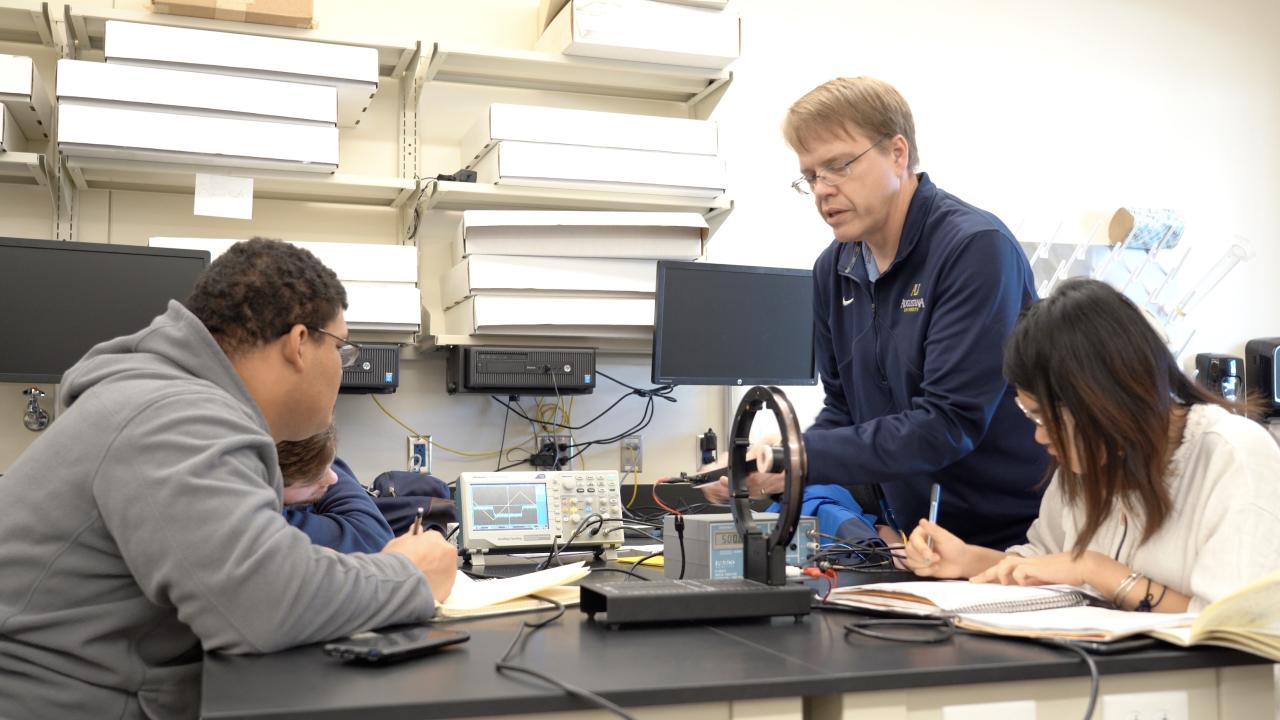The Augustana University Physics Department has secured three grants, totaling more than $450,000 from the National Science Foundation (NSF) — which funds specific research proposals that have been judged to be the most promising by a rigorous merit-review system. The grant money will contribute to “cutting edge experiences” for undergraduate students participating in physics research on Augustana’s campus and across the nation.
Augustana Professor of Physics Dr. Eric Wells said, “We don’t have some of the local resources of some of these elite eschools, but we’re able to leverage our skills so we give the students these cutting edge experiences. We’re taking the model, in terms of Viking Bold, and leveraging the facilities and expertise of our research partners.”
Wells, who came to Augustana in 2003, was awarded a $192,676 grant, entitled “Strong -Field Control of Polyatomic Molecules,” from the NSF to continue undergraduate research in Atomic, Molecular and Optical (AMO) Physics. This is the fifth time his grant has been renewed, which will run through 2023. For more than a decade, Augustana students have been engaged in research involving the interaction of ultrashort laser pulses with small molecules. Ultrashort laser pulses have properties that suggest they might be used to directly influence chemical reactions. The precise application of a customized laser pulse to an individual molecule can enable the modification of the molecule in a targeted, desired manner. This basic research helps to lay a foundation that one day might allow chemical synthesis of novel materials and medicines.
This award will continue a long-standing collaboration between Augustana and Kansas State University. While students develop and analyze experiments on campus, the experiments are carried out at the J.R. Macdonald Laboratory in Manhattan, Kansas.
Wells, along with Assistant Professor of Computer Science Dan Steinwand ‘83, also received an NSF Major Research Instrumentation (MRI) award of nearly $127,000. The grant will fund the acquisition of a hybrid silicon pixel detector to help examine the products resulting from the interactions of molecules with ultrashort laser pulses. Wells says the “fancy camera”, also known as the TPX3Cam, will be used in collaboration with four other institutions, including Michigan State University, Kansas State University, the University of Virginia and University of Mary Washington.
Referring to the MRI grant process, Wells said, “These awards are very competitive. Each proposal from a large research university has already had to win an internal competition to be submitted, so we are not just competing against, for example, Cal Tech (California Institute of Technology), we are competing against the best proposal Cal Tech can send in this year. We’re the primary organization on this grant, and I’m the principal investigator. This means we’re not just tagging along with our research partners in some sense. We’re leading this effort that involves research heavy institutions.”
Funded by NSF’s experimental Nuclear Physics Program, a $135,000 grant was awarded to Dr. Nathan Grau, assistant professor of physics. This grant will mark its third renewal, continuing the scientific program “Studying the Strong Nuclear Force at Augustana University.” Grau, who came to Augustana in 2010, will use the funds to study the gluon content in the nucleus, which is at the core of every atom, by analyzing high energy nuclear collisions produced at Brookhaven National Laboratory in Upton, New York. Along with students, Grau will also participate in the building and installation of a next-generation detector, known as the sPHENIX, that will measure the results of these collisions.
“These awards are just an indication that the work we are doing is that level, since the NSF is funding us. We’re competitive with other nationally supported programs,” said Grau.
